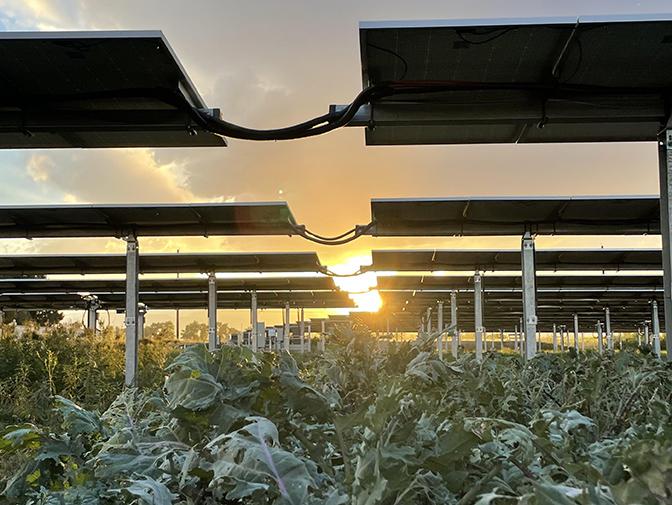- South Texas Students Meet Accordion Music Icons Los Tigres Del Norte In Edinburg Thanks To Khs America/Hohner Alianza Académica Initiative
- Fragile Planet Offers a Nighttime Wildlife Experience
- Falcons Soccer Off & Running
- Cameron County Receives Funds to Improve Two Parks
- Falcons Complete First Half of 32-6A
- School District to Help out Victims of California Wildfires
- Sand Castle Days Continued Despite Unexpected Weather
- Ready for District
- Discussion of Garbage Dumpster Rates, Agreements Between State & City on Highway Regulations, and More
- 31st Annual Shrimp Cook-Off is Right Around the Corner
UTRGV Receives $2.2M Grant for ‘Climate-Smart’ Commodities Project
- Updated: December 25, 2022

By Maria Gonzalez
RIO GRANDE VALLEY, TEXAS – DEC. 12, 2022 – The University of Texas Rio Grande Valley was awarded a $2.2 million grant from the second funding pool of the U.S. Department of Agriculture’s Partnerships for Climate-Smart Commodities.
The grant is part of a historical $325 million federal investment in 71 new projects announced today by Agriculture Secretary Tom Vilsack at Tuskegee University.
According to the USDA announcement, the major investment will deliver on its promise to:
Expand markets for America’s climate-smart commodities.
Leverage the greenhouse gas benefits of climate-smart commodity production.
And provide direct, meaningful benefits to production agriculture, including for small and underserved producers across the country.
Dr. Rafael Almeida, assistant professor of energy sustainability in the UTRGV School of Earth, Environmental and Marine Sciences, will lead the project, titled “VANGUARD: Validating agrivoltaic technology with underserved agricultural producers.”
VANGUARD will scale the co-location of agriculture and solar power infrastructure (agrivoltaics) with underserved producers in South Texas. The project has the dual goal of creating robust climate-smart market opportunities and innovative revenue streams for high-need, underserved producers while generating unprecedented data on the greenhouse gas and environmental benefits of agrivoltaic systems.
Almeida said implementing agrivoltaics could be a potential resolution that promotes energy security and increases farm profitability through energy generation.
Agrivoltaic technology could also mitigate climate change by reducing greenhouse gas emissions. The project team will also evaluate whether it can increase soil carbon sequestration, known as “regenerative agriculture.”
“Decarbonizing the U.S. economy over the next decades to halt climate change will require extensive implementation of renewable energy sources like solar power; yet the question of where to put solar panels is not trivial, with large competition for land that is also needed for other purposes, such as food production and biodiversity conservation,” Almeida said.
“One emerging solution to limit land-use conflicts while achieving food security and decarbonization goals is the dual use of agricultural land to jointly produce food and solar energy – also known as agrivoltaics,” he said.
Dr. Engil Isadora Pereira, assistant professor of soil ecology in the School of Earth, Environmental and Marine Sciences and VANGUARD co-PI, noted on a panel with the U.S. Secretary of Agriculture Tom Vilsack today that water-stressed regions like the Valley are especially promising locations for agrivoltaic development.
“In the Rio Grande Valley, agrivoltaics can create conditions that benefit our soils and crops. In the summer, for example, shade from these solar panels slows down evaporation, giving plants more time to absorb water, stay hydrated and improve production,” Pereira told Vilsack.
“With VANGUARD, we aim to place the underserved Rio Grande Valley at the forefront of agrivoltaic development,” she said.
VANGUARD IMPACT
The market for solar energy is expanding not only in residential areas, but also in rural areas, where industrial-scale facilities with vast swaths of panels are being deployed. This renewable energy source has lower greenhouse gas emissions than fossil fuel sources and is expanding drastically to curb climate change.
“To minimize the displacement of land used for food production as solar energy production expands, we will test the concomitant production of crops and energy through agrivoltaic technology by growing the plants underneath solar panels,” Almeida said.
The USDA grant will sponsor acquisition of solar panels for historically underserved farmers and ranchers. In exchange, Almeida and the award-winning research team will monitor energy production, crop yields, soil conditions and greenhouse gas emissions. Consequently, they will evaluate VANGUARD’s innovative environmental impact and benefits approach.
In addition to reducing land-use conflicts, Almeida’s project will promote using land more profitably by implementing agrivoltaics to support small-scale farm productivity.
“This project is another strong indicator showing UTRGV’s strength and determination toward becoming a research university,” said Dr. John “Can” Saygin, senior vice president for research and dean of the Graduate College.
“VANGUARD will be the striving force to steer and pilot innovative, climate-smart practices while providing direct technical and financial support to socially disadvantaged agricultural producers in the Valley, its communities and the nation,” he said.

JOINT EFFORT FOR SUCCESS
The project will be led by a team of UTRGV faculty and staff that will evaluate the economic and environmental benefits of agrivoltaics and market development strategies to improve adoption by farmers across the Valley.
UTRGV faculty and staff include:
Principal Investigator: Dr. Rafael Almeida, assistant professor of energy sustainability in the School of Earth, Environmental and Marine Sciences.
Evaluation Team: Dr. Alexis Racelis, associate professor of agroecology, and Dr. Engil Pereira, assistant professor of soil ecology.
Outreach and Technical Assistance Team: Colin Cain, executive director, Center for Sustainable Agriculture and Rural Advancement (SARA), and Dr. Horacio Vasquez, professor of mechanical engineering
Market Development Team: The market development team will be a partnership effort between Dr. Anna Erwin, UTRGV assistant professor of environmental social science, and Dr. Diego Cardoso, assistant professor of agricultural economics at Purdue University.
In addition to the project’s three core teams, VANGUARD will recruit and enroll Hispanic farmers and ranchers through the coordination of Hispanic-led community partners in the Rio Grande Valley.
To watch the USDA announcement, visit usda.gov/live.
